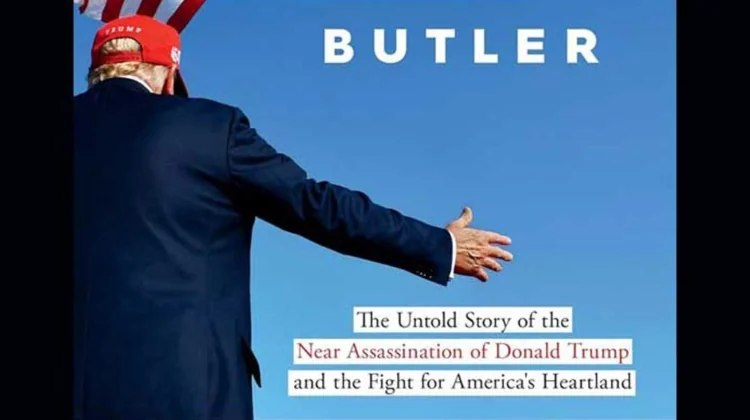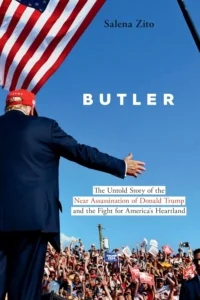
|
Getting your Trinity Audio player ready...
|
[Want even more content from FPM? Sign up for FPM+ to unlock exclusive series, virtual town-halls with our authors, and more—now for just $3.99/month. Click here to sign up.]
During the French and Indian war, an Indian shot at George Washington at close range, obviously intent on killing the young general as he led his troops across what was then known as the Ohio Country. The gunman missed, of course. The attempt took place in the appropriately named Murdering Town.
It is now known as Butler, Pennsylvania.
Donald J. Trump, then, was not the first former president – or president-to-be – who was nearly assassinated in the once unknown little burg of Butler.
Thus reports Salena Zito, a highly gifted writer for the Washington Examiner, in her engaging new book, Butler: The Untold Story of the Near Assassination of Donald Trump and the Fight for America’s Heartland. It’s a riveting piece of journalism from a woman who was in Butler on the fateful day of July 13, 2024, and who closely covered the presidential campaign over the next few months. In Butler, where she was scheduled to interview him after the rally, and had met briefly with him before his speech, Zito was close enough to see Trump flinch and grab his ear, close enough to see the blood streak down his face, close enough to be tackled to the ground by a Trump staffer concerned about her safety. And she was close enough to see Trump rise to his feet and shout “Fight! Fight! Fight!”
Zito lives not far from Butler and had driven to the rally with her daughter and son-in-law. Her Trump interview didn’t take place that day. But the next morning she got a phone call: “Good morning, Salena! It’s Donald Trump. I wanted to see if you and your daughter Shannon and Michael are okay. And I wanted to apologize that we weren’t able to do the interview.” They spoke for twelve minutes. Before the day was over, Trump had phoned her a total of eight times and spoken to her for over an hour. He couldn’t stop pondering the fateful decision he’d made to turn his head just before the bullet touched his ear. He marveled at the crowd’s discipline in the wake of the assault. He expressed astonishment at the number of phone calls he’d received from Democratic opponents who seemed to be sincerely concerned about his well-being. And on the last phone call of the day, he ventured to say that he felt he’d been saved by “the hand of God.”
While some leading Democrats may indeed have had the class to express their concern for Trump’s welfare, the Trump-hating mainstream media weren’t about to change their tune just because of an assassination attempt. One after another, they played down what had happened. The first CNN headline on the assasination attempt read: “Trump injured in incident at Pennsylvania rally.” The despicable Washington Post, notes Zito, “insinuated that it wasn’t a bullet that struck Trump but pieces of glass that clipped his ear” – a mischievous lie that refused to die during the ensuing weeks.

Shortly afterwards, when Kamala Harris was installed as the Democratic nominee, the very same mainstream press that had downplayed the “incident” at Butler professed to detect a groundswell of support for her. In fact, Butler had been a game-changer, not least in the swing state of Pennsylvania. For ordinary Americans, especially for Rust Belt voters who’d been through some tough times in recent years (if not decades), the courageous way in which Trump had lifted his fist and shouted “Fight! Fight! Fight!” was stirring, inspiring, unforgettable. “Seemingly overnight,” writes Zito, residents of the Keystone State “were no longer afraid to place a Trump sign in their yard or fly a Trump flag. I saw signs where I expected to see them, in the more rural areas, but I also saw them in the predominantly Black neighborhoods of Pittsburgh. I saw them in working-class Philadelphia. I saw them spring up in affluent suburban enclaves where supposedly Trump was losing voters, if one believed the ‘experts.’”
Of course the “experts” were wrong. And they were wrong again when Harris picked Tim Walz as her running mate. On MSNBC, CNN, and NPR, Zito heard journalists celebrate his alleged “folksiness, military service, Midwest pragmatism.” One “Democratic operative” on CNN professed that Walz looked and talked “like a lot of the voters we’ve lost to Trump.” No, thought Zito: “Walz is a guy who looks and talks like what they think a Trump voter looks and talks like.” Nor did the know-it-alls get J.D. Vance right when Trump picked him for the number-two spot on the ticket: “The press seemed to miss the story that Vance quite literally embodied the American dream.” Nor did the overpaid, over-credentialed scribblers for the Times and Washington Post and so on recognize that Vance, like Trump, was a hell of a lot smarter than they were – or that Harris and Walz were not just dumb but off-putting to the deplorables in ways to which they, the media, were somehow blind.
The press missed a lot. On the Rust Belt campaign trail with Vance, Zito, who knows the people of her region like the back of her hand, noticed how powerfully the author of Hillbilly Elegy connected with voters, whereas the mainstream-media reporters on the bus – who knew next to nothing about the region and seemed uninterested in learning anything about it – seemed oblivious, stubbornly married to stale notions about the Democrats’ “blue wall” and about the GOP being anathema to blacks, Latinos, and union members. On Election Day 2024, as had happened eight years earlier, the mainstream media were blindsided by the results – and this time, Trump didn’t just eke out an electoral-college victory; he won a majority of the popular vote, including stunning percentages of the black and Latino populations and a decisive victory in every one of the “swing states.”
But surely the most shameful sign of mainstream-media ignorance, indifference, and irresponsibility was the failure of every major press institution in the country to mount a serious investigation of the assassination attempt in Butler. “Where,” asks Zito, “were the deep dives into what happened? Where were the investigative reporters who would dig and dig until they got answers? They aren’t here anymore.” Where, for that matter, a year after Butler, is the government report elucidating the would-be assassin’s motives and possible connections and explaining how this 20-year-old – who was a lousy shot – managed to come so close to killing Donald Trump? Last week it was announced that six of the Secret Service agents who’d been on duty that day in Butler were being suspended for periods between 10 and 42 days – ridiculously tame punishments for such a colossal failure, if indeed this was a question of failure and not of nefarious intent.
Toward the end of her book, Zito reflects gloomily on the criminal incuriosity of the mainstream media about the facts behind the Butler mystery, and on the decline and fall of the mainstream media generally. The cheering news, needless to say, is that so-called mainstream journalists, who with few exceptions are clueless clods inhabiting a New York-to-Washington bubble, are becoming less mainstream, and less influential, every day, while real reporters like Zito, who actually understand the middle Americans they write about, are gaining the readers and reputation they deserve. In Butler, Salena Zito has given us not just a first-class piece of reportage about a major turning point in American political history but a book abounding in the kind of human empathy and insight of which we deserve a great deal more.


Just about all American Presidents have been the targets of Assassins Obama Clinton(Bill)Reagan, Carter from just around like Andrew Jackson and others even before Lincoln